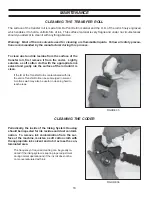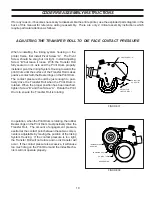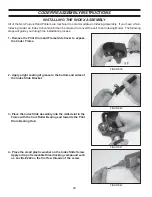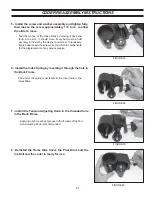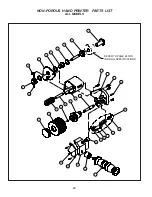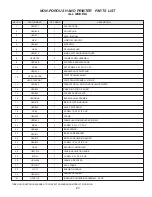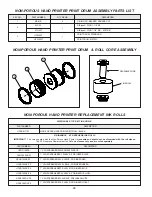
14
Universal Hand Printers are in essence rotary rubber stamping machines. Applying text images from a flat
printing die requires very uniform contact pressure and a very flat surface to transfer a good quality image. By
wrapping a flat die around a print drum and applying the impression in a rolling motion greatly reduces the
contact pressure required and minimizes the adverse affect of an irregular surface. An additional benefit of
rotary stamping is the ability of the system to automatically apply ink to the die face in a very controllable method
thus eliminating smudged impressions caused by over-inking.
Applying text images to non-porous surface such as metal, glass, rubber or plastic, requires the use of specially
formulated inks which introduce an additional set of problems to the process. Understanding the mechanics of
non-porous printing is essential to a successful operation and Universal’s patented method of handling these
special inks is the solution.
Inks designed for printing on non-porous surfaces contain very fast drying alcohol solvents, a component to
impart color which can be either a liquid “dye” or a finely ground solid or “pigment”, and a resin material which
binds the color medium to the surface of the material being printed. When the printed marks are applied by the
printer, the solvents evaporate rapidly from the printed impressions leaving only the dried resin and color.
Solvent base inks that evaporate rapidly at room temperatures to produce fast drying impressions will also
evaporate rapidly from an ink pad or roll if it is exposed to atmosphere. Preventing rapid solvent loss from the
inking system, which would cause the ink roll to dry out, has traditionally been a very difficult task. Universal’s
patented Non-Porous Inking System design has overcome this problem by enclosing all of the inking system
components in a tightly sealed housing.
INKING SYSTEM DESIGN
The two main components of the inking system, as shown in
figure 26, are the Ink Roll and the Transfer or “Anilox” Roll.
Both of these component parts reside in separate precision
machined cavities in the Inking System Housing. When the
Inking System Cover is installed, the minimal clearance be-
tween the Housing walls and the Anilox Roll surface provides
an extremely small air channel for solvent vapor to escape.
With this design the printers can be left idle for days with the
ink rolls installed without adverse affect. The same ink roll left
exposed to atmosphere would dry out in a matter of minutes.
The finely engraved surface of the Anilox Roll in this system
also functions as an ink metering device. Applying a very thin
film of ink to the face of the printing dies not only prevents
smudged impressions caused by over-inking but it also re-
duces the drying time of the impressions by minimizing the
amount of solvent being transferred.
BASIC PRINCIPLES OF OPERATION
FIGURE 26
TRANSFER ROLL
INKING
SYSTEM
HOUSING
INK ROLL
INK OPTIONS
Although the standard #100 Inks are suitable for most non-porous printing applications, other alcohol base inks,
including a variety of pigmented stencil inks, can be used in these coders. It is extremely important, however, to
test the compatibility of the ink with the XF Neoprene Rolls. When fully saturated with ink, the Ink Roll must not
exceed 2.030” diameter. MEK base inks are not compatible with the XF Neoprene Ink Rolls.
Содержание HPNP-100
Страница 25: ...25 ...


















